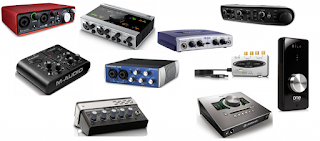Hello and welcome to this week's article!
Today we are going to see if it's possible to combine two audio interfaces in the same computer to sum up all their inputs.
This is particularly useful if we need to record more tracks at the same time, but it creates a big problem: drivers.
The Daw in facts, uses one single driver and assigns it to an audio interface, and if we have two of them, with the driver of both installed, the program lets us just choose one of them.
While the problem is much easier to solve in a Mac environment (you must simply create an aggregate audio device in Audio MIDI Setup and set your main interface as the master clock), in Windows it gets much more complicated.
Basically there are 3 ways:
1) Daisy Chaining the interfaces: sometimes interfaces has a firewire, a Sp-dif or a usb "loop", like an input and a "through" output to connect themselves with other interfaces.
The best brands (like Motu or Presonus) have drivers that can recognize other audio interfaces, usually only the ones made by the same producer, and lets you stack them one upon the other, multiplying the number of input channels.
The clock used is the one of the first Audio Interface, and the others will adapt to that one.
2) Expanding your channels via Adat: This connection has a few names, like Optical, Adat, Lightpipe, but they all mean the same thing: a fiber optic technology that can stream up to 8 channels of stable 44.1 or 48 khz 24 bit digital audio between audio hardwares.
There are many units that add preamp channels and that are made just to be connected to another audio interface (like the Behringer Ada-8000) via Adat, and in this case, once hooked on the Audio interface, the drivers internal mixer should display the extra channels not as a separate audio interface but like additional channels of our first interface.
3) Adding channels to our unit using external preamps and the line inputs of our audio interface: if we don't want or can't pass through the Adat input of our audio interface we can often use our additional preamps, like a mixer or a rack unit like the aforementioned Ada 8000 going from the output of each channel into the line input of our audio interface.
This can be done obviously only with the interfaces that has, besides the preamp inputs, also other line inputs made to be connected with external preamps or other processors.
Also in this case, the additional channels will be considered by the software as part of our main audio interface.
Do you know other ways to expand the input channels of your interface? Share them with us!
Become fan of this blog on Facebook! Share it and contact us to collaborate!!


No comments:
Post a Comment